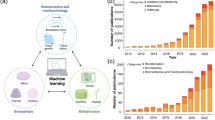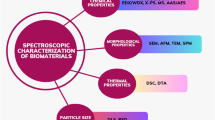Abstract
The extracellular matrix is a dynamic structural component of tissue and plays a key role in wound healing by providing adhesive cues that regulate cell behavior during tissue repair. Macrophages are essential regulators of inflammation and tissue remodeling, and adaptively change their function in different microenvironments. Although much is known about how soluble factors including cytokines and chemokines influence immune cell function, much less is known about how insoluble cues including those presented by the matrix regulate their behavior. The goal of this study is to understand the potential role of different adhesive proteins and their geometric presentation in regulating macrophage behavior. Previously, using micropatterning and topographical features, we observed that macrophage elongation helps to promote polarization towards a pro-healing phenotype. In this work, we found that adhesion to different extracellular matrix ligands had only a moderate effect on macrophage cytokine secretion in response to prototypical activating stimuli. However, expression of arginase-1, a marker of pro-healing phenotype, was enhanced when cells were cultured on laminin, Matrigel, and vitronectin when compared to collagen, fibronectin, or fibrinogen. When micropatterned into lines, almost all matrix ligands allowed elongation of macrophages and a concomitant increase in arginase-1 expression. Together, these data demonstrate that extracellular matrix composition and adhesion geometry influence macrophage cell shape and function.
Lay Summary
In this study, we examined the effects of different extracellular matrix proteins on the phenotypic polarization of macrophages, a major innate immune cell involved in defense against pathogens, wound healing, and progression of many diseases. Our results suggest that the cytokine secretion response of macrophages to inflammatory or wound-healing stimuli was largely independent of the type of adhesion protein on which they were cultured, although laminin, Matrigel, and vitronectin promoted the expression of the pro-healing marker arginase-1. Interestingly, these matrix proteins are all prevalent in tumor environments, where pro-healing macrophages are often observed. Macrophages forced to elongate on patterned substrates of nearly all ECMs increased their expression of arginase-1. The extracellular matrix is dynamic in structure and composition during healing after injury and progression of many diseases including tissue fibrosis, cancer, or cardiovascular disease. This work may provide insight to how adhesion to different matrix environments and geometries regulates macrophages, and their impact on disease.



Similar content being viewed by others
References
Wynn TA, Chawla A, Pollard JW. Macrophage biology in development, homeostasis and disease. Nature. 2013;496(7446):445–55. https://doi.org/10.1038/nature12034.
Anderson JM, Rodriguez A, Chang DT. Foreign body reaction to biomaterials. Semin Immunol. 2008;20(2):86–100. https://doi.org/10.1016/j.smim.2007.11.004.
Martinez FO, Gordon S. The M1 and M2 paradigm of macrophage activation: time for reassessment. F1000Prime Rep. 2014;6:13. https://doi.org/10.12703/P6-13.
Yu X, Buttgereit A, Lelios I, Utz SG, Cansever D, Becher B, et al. The cytokine TGF-beta promotes the development and homeostasis of alveolar macrophages. Immunity. 2017;47(5):903–12 e4. https://doi.org/10.1016/j.immuni.2017.10.007.
Clark RAF, DellaPelle P, Manseau E, Lanigan JM, Dvorak HF, Colvin RB. Blood vessel fibronectin increases in conjunction with endothelial cell proliferation and capillary ingrowth during wound healing. J Investig Dermatol. 1982;79(5):269–76. https://doi.org/10.1111/1523-1747.ep12500076.
O’Toole EA. Extracellular matrix and keratinocyte migration. Clin Exp Dermatol. 2001;26(6):525–30. https://doi.org/10.1046/j.1365-2230.2001.00891.x.
Leight JL, Wozniak MA, Chen S, Lynch ML, Chen CS. Matrix rigidity regulates a switch between TGF-β1-induced apoptosis and epithelial-mesenchymal transition. Mol Biol Cell. 2012;23:781–91. https://doi.org/10.1091/mbc.E11-06-0537.
Hinz B. The extracellular matrix and transforming growth factor-beta1: tale of a strained relationship. Matrix Biol. 2015;47:54–65. https://doi.org/10.1016/j.matbio.2015.05.006.
Duffy RM, Sun Y, Feinberg AW. Understanding the role of ECM protein composition and geometric micropatterning for engineering human skeletal muscle. Ann Biomed Eng. 2016;44(6):2076–89. https://doi.org/10.1007/s10439-016-1592-8.
Frangogiannis NG. The extracellular matrix in myocardial injury, repair, and remodeling. J Clin Invest. 2017;127(5):1600–12. https://doi.org/10.1172/JCI87491.
Jennewein C, Tran N, Paulus P, Ellinghaus P, Eble JA, Zacharowski K. Novel aspects of fibrin(ogen) fragments during inflammation. Mol Med. 2011;17(5–6):568–73. https://doi.org/10.2119/molmed.2010.00146.
Chow S, Di Girolamo N. Vitronectin: a migration and wound healing factor for human corneal epithelial cells. Invest Ophthalmol Vis Sci. 2014;55(10):6590–600. https://doi.org/10.1167/iovs.14-15054.
Barker TH, Engler AJ. The provisional matrix: setting the stage for tissue repair outcomes. Matrix Biol. 2017;60-61:1–4. https://doi.org/10.1016/j.matbio.2017.04.003.
Giussani M, Merlino G, Cappelletti V, Tagliabue E, Daidone MG. Tumor-extracellular matrix interactions: identification of tools associated with breast cancer progression. Semin Cancer Biol. 2015;35:3–10. https://doi.org/10.1016/j.semcancer.2015.09.012.
Pickup MW, Mouw JK, Weaver VM. The extracellular matrix modulates the hallmarks of cancer. EMBO Rep. 2014;15:1243–53. https://doi.org/10.15252/embr.201439246.
Slattery ML, John E, Torres-Mejia G, Stern M, Lundgreen A, Hines L, et al. Matrix metalloproteinase genes are associated with breast cancer risk and survival: the Breast Cancer Health Disparities Study. PLoS One. 2013;8(5):e63165. https://doi.org/10.1371/journal.pone.0063165.
Sorensen HT, Friis S, Olsen JH, Thulstrup AM, Mellemkjaer L, Linet M, et al. Risk of liver and other types of cancer in patients with cirrhosis: a nationwide cohort study in Denmark. Hepatology. 1998;28(4):921–5.
Neglia JP, Fitzsimmons SC, Maisonneuve P, Schoni MH, Schoni-Affolter F, Corey M, et al. The risk of cancer among patients with cystic fibrosis. NEJM. 1995;332(8):494–9.
Du J, Wang Y, Jia L. ECM and atherosclerosis, in Atherosclerosis: risks, mechanisms, and therapies. In: Wang H, Patterson C, editors. Atherosclerosis: risks, mechanisms, and therapies. 1st ed. Hoboken: John Wiley & Sons, Inc; 2015. p. 343–51.
RTA M, MGA E, JPM C, MJE K, PHM S, Merkx M, et al. Imaging collagen in intact viable healthy and atherosclerotic arteries using fluorescently labeled CNA35 and two-photon laser scanning microscopy. Mol Imaging. 2007;6(4):247–60. https://doi.org/10.2310/7290.2007.00021.
Wesley RB II, Meng X, Godin D, Galis ZS. Extracellular matrix modulates macrophage functions characteristic to atheroma: collagen type I enhances acquisition of resident macrophage traits by human peripheral blood monocytes in vitro. Arterioscler Thromb Vasc Biol. 1998;18(3):432–40.
Armstrong JW, Chapes SK. Effects of extracellular matrix proteins on macrophage differentiation, growth, and function: comparison of liquid and agar culture systems. J Exp Zool. 1994;269(3):178–87. https://doi.org/10.1002/jez.1402690303.
Toral D, Zaveri JSL, Dolgova NV, Clare-Salzler MJ, Keselowsky BG. Integrin-directed modulation of macrophage responses to biomaterials. Biomaterials. 2014;35:3504–15. https://doi.org/10.1016/j.biomaterials.2014.01.007.
McWhorter FY, Wang T, Nguyen P, Chung T, Liu WF. Modulation of macrophage phenotype by cell shape. PNAS. 2013;110(43):17253–8. https://doi.org/10.1073/pnas.1308887110.
Wang T, Luu TU, Chen A, Khine M, Liu WF. Topographical modulation of macrophage phenotype by shrink-film multi-scale wrinkles. Biomater Sci. 2016;4(6):948–52. https://doi.org/10.1039/c6bm00224b.
Luu TU, Gott SC, Woo BWK, Rao MP, Liu WF. Micro- and nanopatterned topographical cues for regulating macrophage cell shape and phenotype. ACS Appl Mater Interfaces. 2015;7:28665–72. https://doi.org/10.1021/acsami.5b10589.
Waldo SW, Li Y, Buono C, Zhao B, Billings EM, Chang J, et al. Heterogeneity of human macrophages in culture and in atherosclerotic plaques. Am J Pathol. 2008;172(4):1112–26. https://doi.org/10.2353/ajpath.2008.070513.
Neubrand VE, Pedreno M, Caro M, Forte-Lago I, Delgado M, Gonzalez-Rey E. Mesenchymal stem cells induce the ramification of microglia via the small RhoGTPases Cdc42 and Rac1. Glia. 2014;62(12):1932–42. https://doi.org/10.1002/glia.22714.
Chen S, Jones JA, Xu Y, Low HY, Anderson JM, Leong KW. Characterization of topographical effects on macrophage behavior in a foreign body response model. Biomaterials. 2010;31(13):3479–91. https://doi.org/10.1016/j.biomaterials.2010.01.074.
Biswas S, Bachay G, Chu J, Hunter DD, Brunken WJ. Laminin-dependent interaction between astrocytes and microglia: a role in retinal angiogenesis. Am J Pathol. 2017;187(9):2112–27. https://doi.org/10.1016/j.ajpath.2017.05.016.
Fridman R, Giaccone G, Kanemoto T, Martin GR, Gazdar AF, Mulshine JL. Reconstituted basement membrane (matrigel) and laminin can enhance the tumorgenicity and the drug resistance of small cell lung cancer cell lines. Proc Natl Acad Sci U S A. 1990;87:6698–702.
Hao W, Zhang X, Xiu B, Yang X, Hu S, Liu Z, et al. Vitronectin: a promising breast cancer serum biomarker for early diagnosis of breast cancer in patients. Tumour Biol. 2016;37(7):8909–16. https://doi.org/10.1007/s13277-015-4750-y.
Murata K, Motayama T, Kotake C. Collagen types in various layers of the human aorta and their changes with the atherosclerotic process. Atherosclerosis. 1986;60:251–62. https://doi.org/10.1016/0021-9150(86)90172-3.
Stary HC, Chandler AB, Dinsmore RE, Fuster V, Glagov S, Insull W, et al. A definition of advanced types of atherosclerotic lesions and a histological classification of atherosclerosis. Arterioscler Thromb Vasc Biol. 1995;15:1512–31. https://doi.org/10.1161/01.CIR.92.5.1355.
Shekhonin BV, Domogatsky SP, Idelson GL, Koteliansky VE, Rukosuev VS. Relative distribution of fibronectin and type I, III, IV, V collagens in normal and atherosclerotic intima of human arteries. Atherosclerosis. 1987;67:9–16. https://doi.org/10.1016/0021-9150(87)90259-0.
Colin S, Chinetti-Gbaguidi G, Staels B. Macrophage phenotypes in atherosclerosis. Immmunol Rev. 2014;262:153–66.
Chinetti-Gbaguidi G, Colin S, Staels B. Macrophage subsets in atherosclerosis. Nat Rev Cardiol. 2015;12(1):10–7. https://doi.org/10.1038/nrcardio.2014.173.
Mirza R, DiPietro LA, Koh TJ. Selective and specific macrophage ablation is detrimental to wound healing in mice. Am J Pathol. 2009;175(6):2454–62. https://doi.org/10.2353/ajpath.2009.090248.
Xue M, Jackson CJ. Extracellular matrix reorganization during wound healing and its impact on abnormal scarring. Adv Wound Care (New Rochelle). 2015;4(3):119–36. https://doi.org/10.1089/wound.2013.0485.
Gauglitz GG, Korting HC, Pavicic T, Ruzicka T, Jeschke MG. Hypertrophic scarring and keloids: pathomechanisms and current and emerging treatment strategies. Mol Med. 2011;17(1–2):113–25. https://doi.org/10.2119/molmed.2009.00153.
Hsieh JY, Smith TD, Meli VS, Tran TN, Botvinick EL, Liu WF. Differential regulation of macrophage inflammatory activation by fibrin and fibrinogen. Acta Biomater. 2017;47:14–24. https://doi.org/10.1016/j.actbio.2016.09.024.
Blakney AK, Swartzlander MD, Bryant SJ. The effects of substrate stiffness on the in vitro activation of macrophages and in vivo host response to poly(ethylene glycol)-based hydrogels. J Biomed Mater Res A. 2012;100(6):1375–86. https://doi.org/10.1002/jbm.a.34104.
Swartzlander MD, Lynn AD, Blakney AK, Kyriakides TR, Bryant SJ. Understanding the host response to cell-laden poly(ethylene glycol)-based hydrogels. Biomaterials. 2013;34(4):952–64. https://doi.org/10.1016/j.biomaterials.2012.10.037.
Previtera ML, Sengupta A. Substrate stiffness regulates proinflammatory mediator production through TLR4 activity in macrophages. PLoS One. 2015;10(12):e0145813. https://doi.org/10.1371/journal.pone.0145813.
Acknowledgements
We thank Praveen Krishna Veerasubramanian and Linda McCarthy for technical assistance in the laboratory.
Funding
This work was supported by the National Institutes of Health (NIH) National Institute of Dental and Craniofacial Research (NIDCR) Grant DP2DE023319 and National Institute of Allergy and Infectious Diseases (NIAID) Grant 1R21AI128519-01A1.. T. U. L. was supported by a California Institute of Regenerative Medicine (CIRM) Training Fellowship (TG2-01152).
Author information
Authors and Affiliations
Corresponding author
Ethics declarations
All protocols involving animals were approved by University of California Irvine’s Institutional Animal Care and Use Committee, which is accredited by the Association for the Assessment and Accreditation of Laboratory Animal Care International (AAALACi).
Electronic supplementary material
Rights and permissions
About this article
Cite this article
Luu, T.U., Liu, W.F. Regulation of Macrophages by Extracellular Matrix Composition and Adhesion Geometry. Regen. Eng. Transl. Med. 4, 238–246 (2018). https://doi.org/10.1007/s40883-018-0065-z
Received:
Accepted:
Published:
Issue Date:
DOI: https://doi.org/10.1007/s40883-018-0065-z




